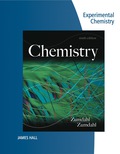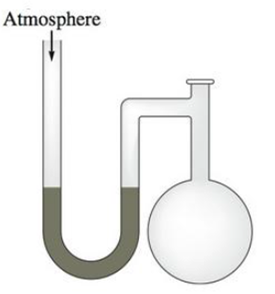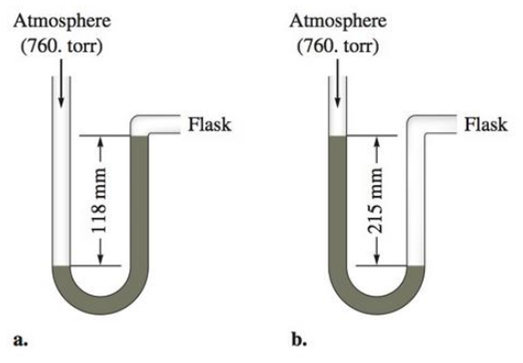
Concept explainers
A diagram for an open-tube manometer is shown below.

If the flask is open to the atmosphere, the mercury levels are equal. For each of the following situations where a gas is contained in the flask, calculate the pressure in the flask in torr, atmospheres, and pascals.

c. Calculate the pressures in the flask in parts a and b (in torr) if the atmospheric pressure is 635 torr.
(a)
Interpretation:
The pressure of the gases in given two situations of manometers (a) and (b) should be determined in units of torr, atm and pascals when the manometer shows a reading of 118mm and 215mm respectively. And also calculate the pressure of the gases in given two situations of manometers (a) and (b) If the atmospheric pressure is 635 torr.
Concept Introduction:
The manometer is a devise used measure the pressure of a gas. The pressure of gas is determined by the value of ‘h’ shown by the manometer. This ‘h’-value is added or subtracted with atmospheric pressure to determine the pressure of gas.
If the flask side mercury level is decreased after the filling of gas, then the ‘h’-value will be added to atmospheric pressure to get the pressure of gas.
If the flask side mercury level is increased after the filling of gas, then the ‘h’-value will be subtracted from the atmospheric pressure to get the pressure of gas.
The pressure equivalent of ‘h’ value is,
Pressure of a substance can be stated in various units. The units of pressure are interconvertible. The relations between units of pressure are,
- Since the unit mm Hg and the unit torr is used interchangeably.
- Conversion of 1 torr into atm is,
- The 1 mm Hg pressure in Pa unit is,
Answer to Problem 41E
The pressure of the given gas (figure-a) in units of torr, atm and pascal are,
642 torr, 0.8447 atm, 85593 Pa
Explanation of Solution
The given ‘h’ value for the gas in manometer is 118mm. The picture of manometer shows the flask side mercury level is increased after the filling of gas.
Hence the equation for finding the pressure of gas is,
That is,
=
=
The calculated pressure is 642 mm Hg; the mm Hg and torr units are used interchangeably,
Therefore,
The calculated pressure is 642mm Hg. So the pressure in atm unit is,
=
The calculated pressure is 642mm Hg. So the pressure in Pa unit is,
(b)
Interpretation:
The pressure of the gases in given two situations of manometers (a) and (b) should be determined in units of torr, atm and pascals when the manometer shows a reading of 118mm and 215mm respectively. And also calculate the pressure of the gases in given two situations of manometers (a) and (b) If the atmospheric pressure is 635 torr.
Concept Introduction:
The manometer is a devise used measure the pressure of a gas. The pressure of gas is determined by the value of ‘h’ shown by the manometer. This ‘h’-value is added or subtracted with atmospheric pressure to determine the pressure of gas.
If the flask side mercury level is decreased after the filling of gas, then the ‘h’-value will be added to atmospheric pressure to get the pressure of gas.
If the flask side mercury level is increased after the filling of gas, then the ‘h’-value will be subtracted from the atmospheric pressure to get the pressure of gas.
The pressure equivalent of ‘h’ value is,
Pressure of a substance can be stated in various units. The units of pressure are interconvertible. The relations between units of pressure are,
- Since the unit mm Hg and the unit torr is used interchangeably.
- Conversion of 1 torr into atm is,
- The 1 mm Hg pressure in Pa unit is,
Answer to Problem 41E
The pressure of the given gas (figure-b) in units of torr, atm and pascal are,
878 torr, 1.1552 atm, 117057 Pa
Explanation of Solution
The given ‘h’ value for the gas in manometer is 118mm. The picture of manometer shows the flask side mercury level is decreased after the filling of gas.
Hence the equation for finding the pressure of gas is,
That is,
=
=
The calculated pressure is 878 mm Hg; the mm Hg and torr units are used interchangeably,
Therefore,
The calculated pressure is 878mm Hg. So the pressure in atm unit is,
=
The calculated pressure is 878mm Hg. So the pressure in Pa unit is,
(c)
Interpretation:
The pressure of the gases in given two situations of manometers (a) and (b) should be determined in units of torr, atm and pascals when the manometer shows a reading of 118mm and 215mm respectively. And also calculate the pressure of the gases in given two situations of manometers (a) and (b) If the atmospheric pressure is 635 torr.
Concept Introduction:
The manometer is a devise used measure the pressure of a gas. The pressure of gas is determined by the value of ‘h’ shown by the manometer. This ‘h’-value is added or subtracted with atmospheric pressure to determine the pressure of gas.
If the flask side mercury level is decreased after the filling of gas, then the ‘h’-value will be added to atmospheric pressure to get the pressure of gas.
If the flask side mercury level is increased after the filling of gas, then the ‘h’-value will be subtracted from the atmospheric pressure to get the pressure of gas.
The pressure equivalent of ‘h’ value is,
Pressure of a substance can be stated in various units. The units of pressure are interconvertible. The relations between units of pressure are,
- Since the unit mm Hg and the unit torr is used interchangeably.
- Conversion of 1 torr into atm is,
- The 1 mm Hg pressure in Pa unit is,
Answer to Problem 41E
The pressure of the given gas (figure-a) in units of torr, atm and pascal when the atmospheric pressure is 635 torr are,
517 torr, 0.8141 atm, 82496 Pa
The pressure of the given gas (figure-b) in units of torr, atm and pascal when the atmospheric pressure is 635 torr are,
753 torr, 1.1858 atm, 120154 Pa
Explanation of Solution
The pressure of the gas in given situation of manometer (a) in units of torr, atm and pascals:
The given ‘h’ value for the gas in manometer (a) is 118mm. The picture of manometer shows the flask side mercury level is increased after the filling of gas.
Hence the equation for finding the pressure of gas is,
That is,
=
=
The calculated pressure is 517 mm Hg; the mm Hg and torr units are used interchangeably,
Therefore,
The calculated pressure is 517mm Hg. So the pressure in atm unit is,
=
The calculated pressure is 517mm Hg. So the pressure in Pa unit is,
The pressure of the gas in given situation of manometer (b) in units of torr, atm and pascals:
The given ‘h’ value for the gas in manometer is 118mm. The picture of manometer shows the flask side mercury level is decreased after the filling of gas.
Hence the equation for finding the pressure of gas is,
That is,
=
=
The calculated pressure is 753 mm Hg; the mm Hg and torr units are used interchangeably,
Therefore,
The calculated pressure is
=
The calculated pressure is
Want to see more full solutions like this?
Chapter 5 Solutions
Lab Manual For Zumdahl/zumdahl's Chemistry, 9th
- Are there any alternative methods better than the MOHR titration to quantitatively determine salt in a sample?arrow_forwardhybridization of nitrogen of complex moleculesarrow_forwardUsing reaction free energy to predict equilibrium composition Consider the following equilibrium: 2NO2 (g) = N2O4(g) AGº = -5.4 kJ Now suppose a reaction vessel is filled with 4.53 atm of dinitrogen tetroxide (N2O4) at 279. °C. Answer the following questions about this system: Under these conditions, will the pressure of N2O4 tend to rise or fall? Is it possible to reverse this tendency by adding NO2? In other words, if you said the pressure of N2O4 will tend to rise, can that be changed to a tendency to fall by adding NO2? Similarly, if you said the pressure of N2O4 will tend to fall, can that be changed to a tendency to '2' rise by adding NO2? If you said the tendency can be reversed in the second question, calculate the minimum pressure of NO 2 needed to reverse it. Round your answer to 2 significant digits. 00 rise ☐ x10 fall yes no ☐ atm G Ar 1arrow_forward
- Why do we analyse salt?arrow_forwardCurved arrows are used to illustrate the flow of electrons. Using the provided starting and product structures, draw the curved electron-pushing arrows for the following reaction or mechanistic step(s). Be sure to account for all bond-breaking and bond-making steps. H H CH3OH, H+ H Select to Add Arrows H° 0:0 'H + Q HH ■ Select to Add Arrows CH3OH, H* H. H CH3OH, H+ HH ■ Select to Add Arrows i Please select a drawing or reagent from the question areaarrow_forwardWhat are examples of analytical methods that can be used to analyse salt in tomato sauce?arrow_forward
- A common alkene starting material is shown below. Predict the major product for each reaction. Use a dash or wedge bond to indicate the relative stereochemistry of substituents on asymmetric centers, where applicable. Ignore any inorganic byproducts H Šali OH H OH Select to Edit Select to Draw 1. BH3-THF 1. Hg(OAc)2, H2O =U= 2. H2O2, NaOH 2. NaBH4, NaOH + Please select a drawing or reagent from the question areaarrow_forwardWhat is the MOHR titration & AOAC method? What is it and how does it work? How can it be used to quantify salt in a sample?arrow_forwardPredict the major products of this reaction. Cl₂ hv ? Draw only the major product or products in the drawing area below. If there's more than one major product, you can draw them in any arrangement you like. Be sure you use wedge and dash bonds if necessary, for example to distinguish between major products with different stereochemistry. If there will be no products because there will be no significant reaction, just check the box under the drawing area and leave it blank. Note for advanced students: you can ignore any products of repeated addition. Explanation Check Click and drag to start drawing a structure. 80 10 m 2025 McGraw Hill LLC. All Rights Reserved. Terms of Use | Privacy Center | Accessibility DII A F1 F2 F3 F4 F5 F6 F7 F8 EO F11arrow_forward
- Given a system with an anodic overpotential, the variation of η as a function of current density- at low fields is linear.- at higher fields, it follows Tafel's law.Calculate the range of current densities for which the overpotential has the same value when calculated for both cases (the maximum relative difference will be 5%, compared to the behavior for higher fields).arrow_forwardUsing reaction free energy to predict equilibrium composition Consider the following equilibrium: N2 (g) + 3H2 (g) = 2NH3 (g) AGº = -34. KJ Now suppose a reaction vessel is filled with 8.06 atm of nitrogen (N2) and 2.58 atm of ammonia (NH3) at 106. °C. Answer the following questions about this system: rise Under these conditions, will the pressure of N2 tend to rise or fall? ☐ x10 fall Is it possible to reverse this tendency by adding H₂? In other words, if you said the pressure of N2 will tend to rise, can that be changed to a tendency to fall by adding H2? Similarly, if you said the pressure of N will tend to fall, can that be changed to a tendency to rise by adding H₂? If you said the tendency can be reversed in the second question, calculate the minimum pressure of H₂ needed to reverse it. Round your answer to 2 significant digits. yes no ☐ atm Х ด ? olo 18 Ararrow_forwardFour liters of an aqueous solution containing 6.98 mg of acetic acid were prepared. At 25°C, the measured conductivity was 5.89x10-3 mS cm-1. Calculate the degree of dissociation of the acid and its ionization constant.Molecular weights: O (15.999), C (12.011), H (1.008).Limiting molar ionic conductivities (λ+0 and λ-0) of Ac-(aq) and H+(aq): 40.9 and 349.8 S cm-2 mol-1.arrow_forward
 Chemistry: Principles and ReactionsChemistryISBN:9781305079373Author:William L. Masterton, Cecile N. HurleyPublisher:Cengage Learning
Chemistry: Principles and ReactionsChemistryISBN:9781305079373Author:William L. Masterton, Cecile N. HurleyPublisher:Cengage Learning Chemistry: An Atoms First ApproachChemistryISBN:9781305079243Author:Steven S. Zumdahl, Susan A. ZumdahlPublisher:Cengage Learning
Chemistry: An Atoms First ApproachChemistryISBN:9781305079243Author:Steven S. Zumdahl, Susan A. ZumdahlPublisher:Cengage Learning Chemistry: Principles and PracticeChemistryISBN:9780534420123Author:Daniel L. Reger, Scott R. Goode, David W. Ball, Edward MercerPublisher:Cengage Learning
Chemistry: Principles and PracticeChemistryISBN:9780534420123Author:Daniel L. Reger, Scott R. Goode, David W. Ball, Edward MercerPublisher:Cengage Learning General Chemistry - Standalone book (MindTap Cour...ChemistryISBN:9781305580343Author:Steven D. Gammon, Ebbing, Darrell Ebbing, Steven D., Darrell; Gammon, Darrell Ebbing; Steven D. Gammon, Darrell D.; Gammon, Ebbing; Steven D. Gammon; DarrellPublisher:Cengage Learning
General Chemistry - Standalone book (MindTap Cour...ChemistryISBN:9781305580343Author:Steven D. Gammon, Ebbing, Darrell Ebbing, Steven D., Darrell; Gammon, Darrell Ebbing; Steven D. Gammon, Darrell D.; Gammon, Ebbing; Steven D. Gammon; DarrellPublisher:Cengage Learning Introductory Chemistry: A FoundationChemistryISBN:9781337399425Author:Steven S. Zumdahl, Donald J. DeCostePublisher:Cengage Learning
Introductory Chemistry: A FoundationChemistryISBN:9781337399425Author:Steven S. Zumdahl, Donald J. DeCostePublisher:Cengage Learning World of Chemistry, 3rd editionChemistryISBN:9781133109655Author:Steven S. Zumdahl, Susan L. Zumdahl, Donald J. DeCostePublisher:Brooks / Cole / Cengage Learning
World of Chemistry, 3rd editionChemistryISBN:9781133109655Author:Steven S. Zumdahl, Susan L. Zumdahl, Donald J. DeCostePublisher:Brooks / Cole / Cengage Learning





